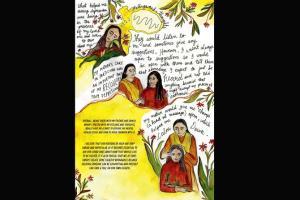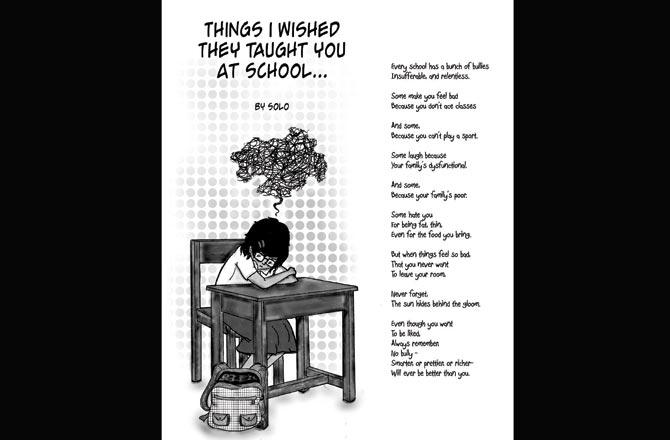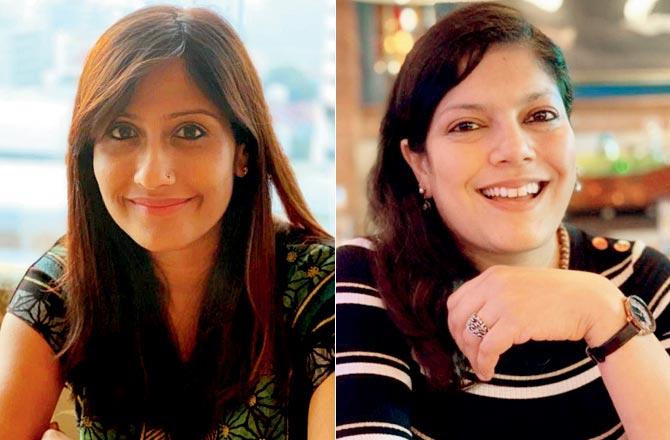A new book packs expert insights, first-person accounts, art and studies to highlight diverse aspects of mental health in young people

An illustration on tackling depression by Ishita Mehra for The Health Collective. Pics courtesy/Young Mental Health
Growing up in a small town with no access to any resources to understand homosexuality meant questioning everything about me," writes Anwesh Pokkuluri, one of the petitioners against Section 377, in the book Young Mental Health (Simon & Schuster India) by Amrita Tripathi and Meera Haran Alva. "Also, since there weren't any role models, I spent all my teenage years in confusion, helplessness, anger and denial; but if there was one emotion that was central to all of it, it was fear," he adds, sharing how his experiences, coupled with the pressure to "be good", among other factors, amounted to depression and suicidal ideation. Pokkuluri isn't alone.
ADVERTISEMENT
According to an article cited in the book, "studies conducted among school-going adolescents in urban India indicate that at least one in five adolescents endure high stress levels in their daily lives".

The book is punctuated with affirmative artwork like this one by Adwaita Das
While the pandemic has shone the light on mental health, the emotional well-being of children is often ignored. Tripathi and Haran Alva help us understand the many dimensions of young mental health, especially issues such as depression, anxiety, stress and bullying, and how parents, schools and children can talk about it.
Basics first
Kids and young adults often do not have the capacity to identify their feelings, and even if they do, are deprived of the vocabulary to express the same. To address this, one needs to first understand what constitutes young mental health. "It usually concerns the age group of 10 to 24 years — spanning adolescence and overlapping with young adulthood. The issues that often go unnoticed [during this time] include self-harm, disabilities, abuse, bullying and body image," says Haran Alva, a psychotherapist and psychologist, adding that it can also be difficult to talk about matters such as sex and relationships, grief, family issues, depression and anxiety. The book, which is second in Tripathi's Mindscape series, addresses these subjects through interviews with experts including child and adolescent psychiatrist Dr Amit Sen, iCall helpline programme coordinator Tanuja Babre, among others, and first-person accounts. Tripathi, the founder-editor of The Health Collective, adds that another aspect of young mental that is most often ignored is suicide. According to research cited in the book, suicide is the leading cause of death for Indians in the age group of 15 to 39 years. "Based on this fact, we decided to also cover the issue through interviews that discuss suicidal ideation, along with trigger warnings and third-party helplines, which is critical."

Art focusing on bullying by Bengaluru-based cartoonist Solo
A new school of thought
In one of the sections, interviews with Dr Sen highlight the role India's schooling system plays in affecting kids' holistic development. Elaborating on this, Haran Alva, who has worked with schools, says, "Over-emphasis on academics and unrealistic expectations brings with it high levels of anxiety, stress and depression, leading to our children feeling unworthy, and thus, self-harming themselves." In the current context of the pandemic, she adds, there are new concerns — online education and its impact on children's physical and mental health, she shares. Drawing from the Fortis School Mental Health Program, Dr Samir Parikh and Kamna Chhibber, in the book, suggest a few approaches that schools can employ:
. Utilising peer influence to promote life skills.
. Mental health advocacy for the youth through them, and by training teachers and staff.
. Creating a movement for bully-to-buddy.
. Creating resources to seek help.

Meera Haran Alva and Amrita Tripathi
Dealing with bullying
In the book, Dr Sen also emphasises on the impact of bullying and peer pressure on children's psyche. "Bullying is rampant across cultures, across different age groups and socio-cultural spaces, so it's not just in schools, though it's most common in schools, and is one of the central factors to affect mental health in children," he writes, categorising it into three kinds — physical, emotional and cyber. Referring to an art work by a Bengaluru-based artiste, who is also featured in the book, Tripathi says, "The distressing part of bullying is the feeling that one is at the other person's mercy. I think we all need to be alert to signs of a child being bullied. We must learn to talk to them on what's acceptable behaviour and what isn't."
Learn, discuss, share
Both authors tell us that the need of the hour is the engagement of all key stakeholders invested in young people's mental health — schools, parents, medical professionals and of course, children. "The statistics makes it clear that it's imperative we learn to address these issues, and to do that we must learn more ourselves, and how to talk about them. Behind the numbers, of course, are everyday people and families, who don't get the support they need. So there's a need for systemic change, yes, but we all need to be part of this movement at an individual level," signs off Tripathi.
Log on to amazon.in to buy the book
Be mindful
Meera Haran Alva shares dos and don'ts for parents while dealing with kids and teens who have anxiety.
. Be curious about your child's feelings and ask open-ended questions.
. Don't pre-empt your child's fears.
. Encourage their efforts.
. When children talk to their parents about their worst fears, having a contingency plan helps them feel less anxious.
For more details, refer to Haran Alva's detailed guide for parents in part two of the book, which also includes case studies.
Catch up on all the latest Mumbai news, crime news, current affairs, and a complete guide from food to things to do and events across Mumbai. Also download the new mid-day Android and iOS apps to get latest updates.
Mid-Day is now on Telegram. Click here to join our channel (@middayinfomedialtd) and stay updated with the latest news
 Subscribe today by clicking the link and stay updated with the latest news!" Click here!
Subscribe today by clicking the link and stay updated with the latest news!" Click here!







